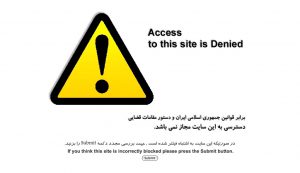After a series of anti-government protests in several cities across Iran, Iranian officials have been busy trying to take online control by censoring and blocking access to several websites and applications over the last few months. Services such as Telegram (access has since been restored) and Instagram were the most recent additions to the pervasive internet control with a confirmed “886 domains” according to OONI.
Shortly after the recent blockage of Telegram, Iranians took to the internet under several social media sites expressing their concern over their right to a free internet. Tweets under the hashtag #filternet has been a way for Iranian citizens to share their thoughts on the situation as the issues were raised.
can not access the @digitalocean from #Iran #filternet any more. #IranianProtests
— jadi (@jadi) January 3, 2018
While the Iranian citizens have been as vocal as they can with their limited access to the “global internet”; statements coming from government heads and even their Supreme Leader, Ayatollah Ali Khamenei have further brought more people to the realization that the future of Iran’s internet situation is looking fairly grim.
It was brought to the attention of the public that Ayatollah Ali Khamenei had been discussing how to “do something about cyberspace” with “cyberspace experts” after his concerns about the challenges that cyberspace and a free internet would pose to the power of the Islamic Republic of Iran, reported Ayatollah Ahmad Jannati – who happens to be the chairman of the “Assembly of Experts” and chairman of the “Guardian Council”, two very important titles. Ayatollah Ahmad Khatami went on further to say that the protests that led to the action of Telegram, was coordinated by “cyberspace seditionists”. He moved on by saying “Cyberspace as a platform is a mad dog,” continuing with “If left alone, it will bite again”. It was during the first few stages of the protests in which Iran had temporarily suspended access to the messaging service, Telegram and Instagram due to the suspicion that “foreign enemies” were using the platforms to engage in protest talks.
These actions and statements from the Islamic Republic have yet again, proven the ability to manage Iranian citizen’s access to the global web with their increasing skills at being able to censor foreign applications and services. Even after the exponential growth of internet use in Iran, the growing amount of censored domains continues to soar, proving an agenda from the Islamic Republic that is being pushed on its citizens in an attempt to further stray them from alternative sources of news media, as opposed to the myriad of government owned and operated news sources.
Due to the rapid decrease of demonstrations within the last few weeks, the Islamic Republic decided to remove its block on Telegram. Telegram had made a move by suspending some Telegram channels in Iran which were responsible for encouraging acts of violence within the protests. Many believe the action was taken after Iranian officials had informed Telegram that access to the app would not be returned until “terrorist content” had been taken down.
Moving forward after the recent suspensions and censorship on the global net in Iran, with motives clear and demonstrated by the Islamic Republic – I believe it is only a matter of time before more bans and blockages will arise again and send woes throughout the Iranian citizens on their freedom to the global net.

